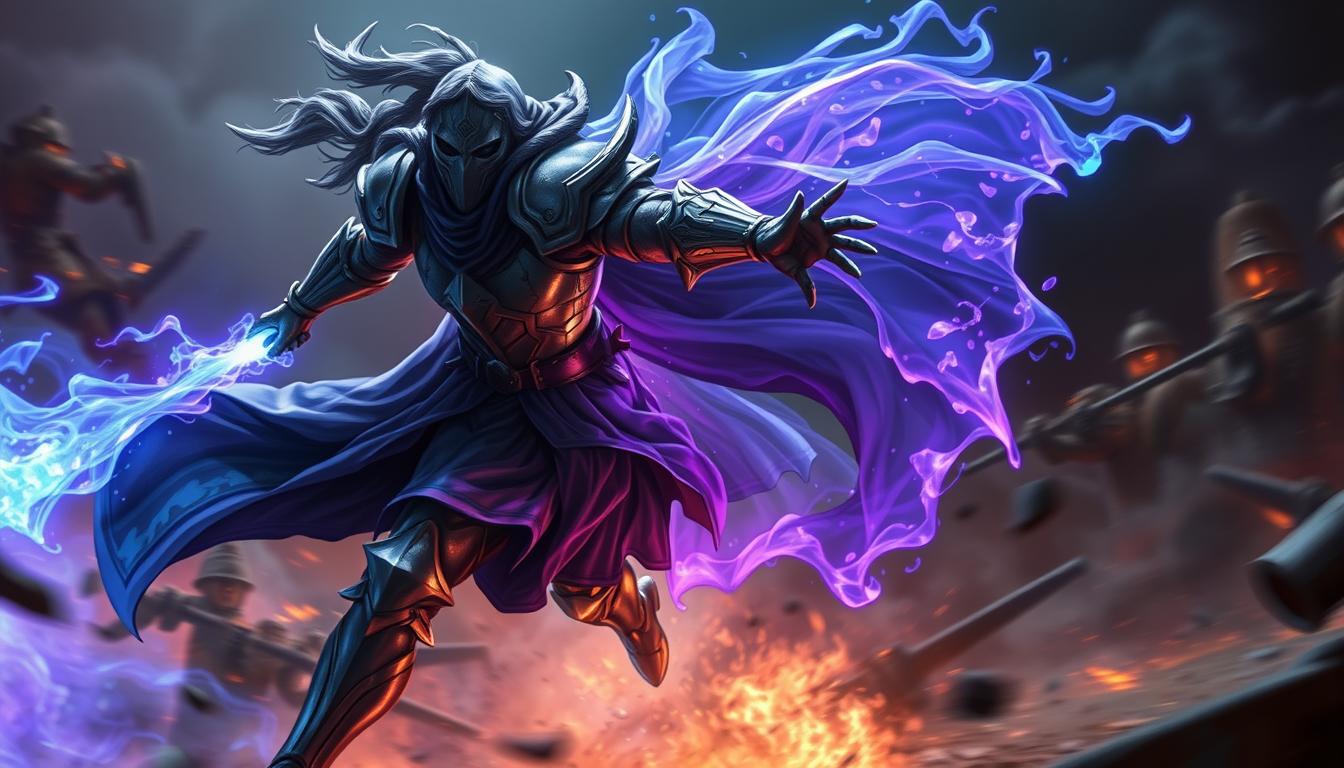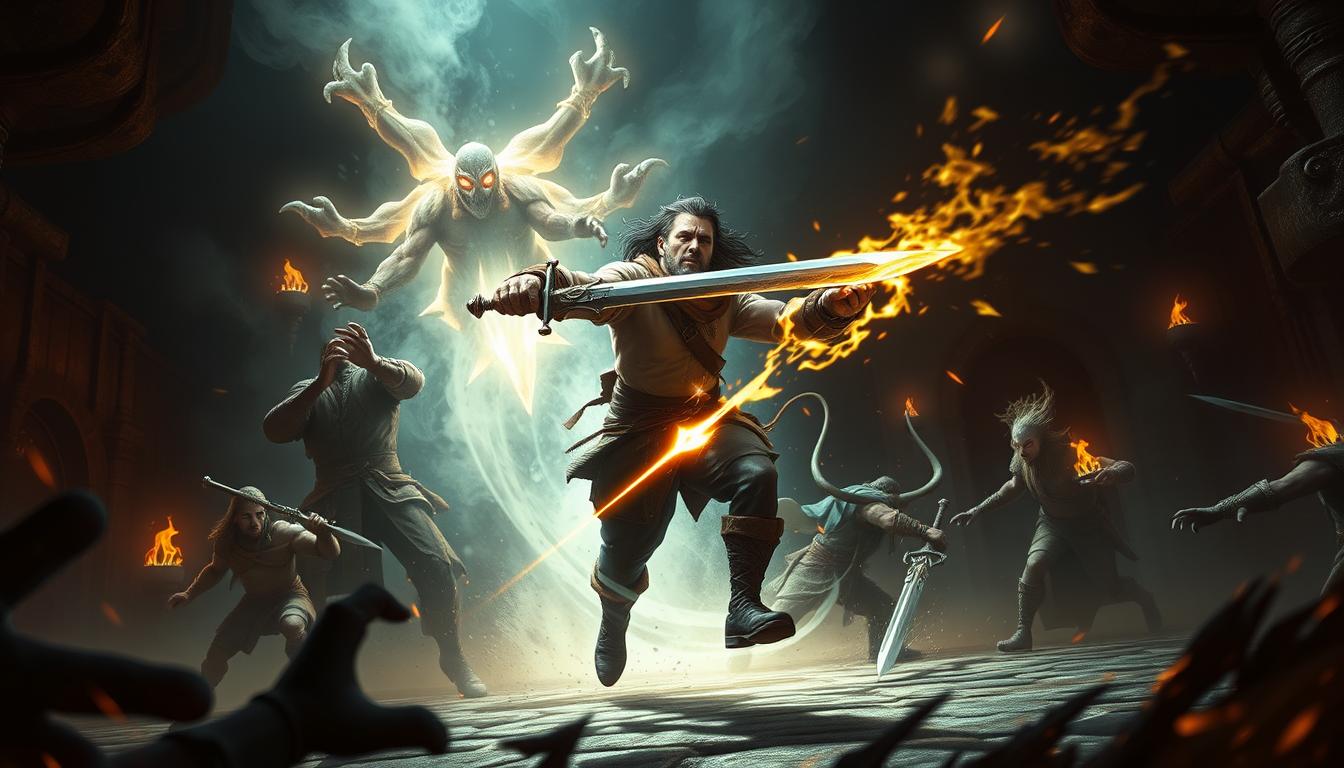Haste Spell 5e: Boost Your Adventurer's Speed
Ever wondered how a single action could turn the tide of battle in Dungeons & Dragons? I remember the first time I used this powerful ability—my character moved like lightning, striking twice before enemies could react. It was a game-changer.

During my Avernus campaign, this magic transformed our party’s combat strategy. We went from struggling against devils to controlling the battlefield. The extra attack and doubled speed gave us an edge no one saw coming.
But power comes with risks. Maintaining focus while dodging fireballs? That’s the real challenge. In this guide, I’ll share hard-won insights about maximizing benefits while avoiding common pitfalls.
Key Takeaways
- Doubles movement speed for tactical positioning advantages
- Grants an additional action each turn for devastating combos
- Requires careful concentration management in heated battles
- Works exceptionally well with martial classes and rogues
- Creates memorable moments when timed perfectly
What Is the Haste Spell in D&D 5e?
Few abilities in D&D deliver such instant combat advantages as this magic. As a 3rd-level transmutation, it requires verbal, somatic, and material components (a shaving of licorice root) with a 30-foot range. I’ve watched it turn sluggish fighters into blurry whirlwinds of destruction.
How It Works Mechanically
The magic grants three benefits for 1 minute:
- Doubled speed: Move like the wind, perfect for hit-and-run tactics.
- +2 AC: Enhanced reflexes make you harder to hit.
- Extra action: Limited to one weapon attack, Dash, or Hide per turn.
During a siege encounter, my rogue used the extra action to Dash, Hide, and snipe—all in one turn. The DM never saw it coming.
Spell Duration and Concentration
Lasting up to 10 rounds, this effect demands constant focus. Lose concentration (e.g., from taking damage), and the target suffers lethargy—losing a turn. I learned this the hard way when a fireball interrupted my wizard’s focus mid-battle.
| Feature | Haste | Expeditious Retreat |
|---|---|---|
| Speed Bonus | ×2 | +Dash action |
| AC Increase | +2 | None |
| Concentration | Yes | Yes |
Unlike Expeditious Retreat, this magic offers defensive boosts alongside raw velocity. But choose wisely—both consume your concentration slot.
Why the Haste Spell 5e Is a Game-Changer
Speed wins fights, and nothing delivers it better than this. When every second counts, the advantages stack up fast—doubled movement, sharper defenses, and an additional action to outpace foes.
Doubled Speed and AC Bonus
Facing a red dragon, my paladin’s 120ft flying speed let us kite its breath weapon. The +2 AC bonus? It deflected a disintegration ray from a beholder—turning a crit into a near-miss.
This combo shines in hit-and-run tactics:
- Reposition freely: Escape grapples or flank effortlessly.
- Dodge deadly AOEs: Outrun fireballs or dragon breath.
- Bait reactions: Lure enemies into unfavorable moves.
The Power of an Additional Action
One extra action per turn rewrites action economy. Compare a fighter’s standard turn vs. a Hasted one:
| Turn Type | Actions | Damage Output |
|---|---|---|
| Normal | 2 attacks | 22 (2d6+15) |
| Hasted | 3 attacks + Dash | 33 (3d6+15) |
That’s 50% more damage plus mobility. Rogues benefit even more—sneak attack twice per round with clever positioning.
Haste’s Limitations and Risks
Every powerful ability has its trade-offs, and this speed boost is no exception. During a climactic battle with a mind flayer, my wizard lost concentration after taking psychic damage. The fighter immediately collapsed, wasting three turns of setup.

The “One Weapon Attack Only” Rule
The extra action comes with strict limits. As per official rules: “That action can be used only to take the Attack (one weapon attack only), Dash, Disengage, Hide, or Use an Object action.”
This means:
- No multi-attacks with the bonus action
- No spellcasting with the extra turn
- Rogues can’t dual-wield for two sneak attacks
Lethargy: The Spell’s Major Drawback
When the spell ends, the target can’t move or take actions for 1 turn. In a 10-round combat, this penalty erases 10% of their effectiveness.
| Scenario | Actions Lost | Damage Potential Lost |
|---|---|---|
| Early drop (Round 3) | 7 | 77 (7d6+35) |
| Full duration | 1 | 11 (1d6+5) |
Compare this to Bless, which has no drop-off penalty. The War Caster feat helps maintain focus, giving advantage on concentration checks when taking damage.
Smart positioning matters too. I now cast from behind cover, using the Dodge action when enemies get too close. It’s saved multiple encounters from disaster.
Haste Spell Synergies You Should Exploit
Timing your speed boost with other abilities creates explosive combat potential. During my Avernus campaign, our fighter achieved six actions in one round by stacking effects. The key lies in understanding how class features interact.
Combining Haste with Action Surge
When our party’s fighter used Action Surge while enhanced, the math got scary:
- Normal attack: 2 actions
- With speed boost: +1 extra attack
- Action Surge: 2 more actions
That’s five weapon swings in six seconds. Add a bonus action for six total moves. The demon lord never stood a chance.
But there’s a catch. This burns both your wizard’s spell slot and the fighter’s once-per-combat ability. I reserve it for boss fights when we need burst damage.
Best Class Pairings for Haste
Some classes benefit more than others:
- Bladesingers: Their extra attack stacks beautifully with the speed boost
- Eldritch Knights: Weapon bond lets them recall thrown weapons mid-flurry
- Rogues: Doubled movement enables perfect sneak attack positioning
My current wizard always preps this for our fighter. The +2 AC helps them survive longer while dealing insane damage. Just remember - if concentration breaks, that wasted turn hurts twice as much.
Tactical Uses of Haste in Combat
Nothing reshapes a battlefield faster than perfect timing and explosive speed. I’ve seen parties turn impossible fights into victories by mastering these combat tactics. The key lies in understanding how to maximize every round.
Shock and Awe: First-Round Burst Strategies
Opening moves matter most. Here’s how we crushed a dragon cult in Avernus:
- Round 1: Wizard casts speed boost on the fighter
- Movement: Fighter closes 120ft gap in one turn
- Action Surge: Five attacks with a lightning-charged greatsword
The table below shows damage potential differences:
| Strategy | Attacks | Damage Output |
|---|---|---|
| Normal Opening | 2 | 24 (2d12+10) |
| Speed Boost Combo | 5 | 60 (5d12+25) |
With the Alert feat, you can guarantee going first. This lets you eliminate key targets before they act.
Hit-and-Run Tactics with Doubled Speed
Mobility wins wars. My rogue uses these patterns:
- Approach: 60ft movement to flank
- Strike: Sneak attack with rapier
- Retreat: 60ft back to cover
Most enemies can’t chase 120ft per turn. The +2 AC makes disengaging safer too. For spellcasters, this means:
- Move into range
- Cast scorching ray
- Dash to safety
Remember - the extra action can’t be used for spells. But it’s perfect for dodging or hiding after casting.
Haste vs. Other Speed-Boosting Spells
Choosing the right speed-enhancing magic can make or break your combat strategy. I’ve tested them all in different scenarios—from tight dungeon corridors to open battlefields. Each option shines in specific situations.

How It Compares to Expeditious Retreat
While both enhance movement, they serve different purposes. Expeditious Retreat gives bonus Dash actions but lacks defensive boosts. Here’s how they stack up:
| Feature | Haste | Expeditious Retreat |
|---|---|---|
| Spell Level | 3rd | 1st |
| AC Bonus | +2 | None |
| Extra Actions | 1 limited | Dash only |
I prefer Haste for frontline fighters who need survivability. For scouts or hit-and-run specialists, the 1st-level option works better.
When to Choose Haste Over Slow
These two 3rd-level spells represent opposite approaches. Slow weakens enemies, while our focus spell boosts allies. Consider these factors:
- Party size: Small groups benefit more from self-buffs
- Enemy count: Against hordes, debuffs often outperform buffs
- Action economy: One boosted martial can outpace multiple weakened foes
In my Waterdeep campaign, we used both strategically. The wizard would Slow enemies while I enhanced our rogue. The combo created perfect flanking opportunities.
Here’s my rule of thumb: choose Haste when you need to focus fire single targets. Pick Slow when facing groups of dangerous enemies. Both consume concentration, so plan accordingly.
Common Misconceptions About Haste
Many players misunderstand how this powerful ability truly works. I’ve seen countless debates at gaming tables about its limits and possibilities. Let’s clear up the confusion once and for all.
Myth: Haste Grants a Full Attack Action
The extra action isn’t as flexible as some think. Rules clearly state it can only be used to:
- Make one weapon attack (not multi-attack)
- Dash to cover ground quickly
- Disengage from melee safely
- Hide to gain advantage
During a tournament, I watched a fighter try to use all four attacks with their extra turn. The DM had to shut it down fast. Here’s what the rules actually allow:
| Action Type | Allowed with Haste? |
|---|---|
| Full Attack Action | No |
| Single Weapon Attack | Yes |
| Cast a Spell | No |
| Use Magic Item | Yes (as Use Object) |
Myth: You Can Cast Two Spells with Haste
This fantasy makes sense in theory but breaks game balance. The rules are clear:
- Bonus action spells limit your main action to cantrips
- The extra turn can’t be used for spellcasting
- Sage Advice confirms this restriction
I once played with a sorcerer who tried to twin Fireball using their extra turn. The table erupted in protests. Now I keep these references handy:
- PHB pg. 202 (Bonus Action Spell rules)
- Sage Advice Compendium v2.8
- Jeremy Crawford’s Twitter rulings
For new players, I recommend this cheat sheet:
- Green = allowed actions
- Red = prohibited moves
- Yellow = situational uses
Understanding these limits before combat saves everyone time and frustration. Trust me - nothing kills the mood faster than rules arguments mid-battle.
Real-World Example: Haste in Action
The numbers don’t lie—this combo delivers devastating results when executed right. During our Avernus campaign, we turned a near-TPK into victory using perfect timing. The fighter-wizard partnership became our signature move against tough bosses.
The Fighter-Wizard Combo from Avernus
Here’s how we maximized actions per turn:
- Round 1: Wizard casts speed boost (concentration check DC 10)
- Fighter’s turn: 90ft movement, three attacks (normal + bonus)
- Action Surge: Two additional greatsword swings
- Enemy turn: Wizard maintains distance (+2 AC helps)
The math shocked our DM:
| Resource | Normal | Enhanced |
|---|---|---|
| Actions | 2 | 5 |
| Damage | 24 (2d12+10) | 60 (5d12+25) |
| Threat Range | 30ft | 90ft |
Calculating Maximum Actions per Turn
With optimal feats, the potential increases further:
- Dual Wielder: +1 AC during flurries
- Great Weapon Master: +10 damage per hit
- Mobile: Extra movement after attacking
Risk assessment matters too. I always:
- Position behind half-cover (+2 AC)
- Keep bonus action spells ready
- Have contingency plans if concentration breaks
The action surge combo works best against single targets. For groups, we switch to area control spells. Either way, understanding these mechanics gives your party a serious edge.
Conclusion: Mastering Haste for Ultimate Speed
After dozens of battles, I’ve learned this power’s true potential lies in smart execution. The doubled speed and extra action can dominate fights—but only if you manage risks.
For new players, try these safe builds first:
- Eldritch Knight: Self-cast for relentless strikes
- Rogue/Wizard: Hit, hide, repeat with sneak attack
- Bladesinger: Defensive magic with melee pressure
Want epic-level tricks? Combine with Mirror Image or spell glyphs. Just remember—losing focus hurts more than any attack.
Share your best speed stories below! What’s your wildest “I moved how fast?!” moment?